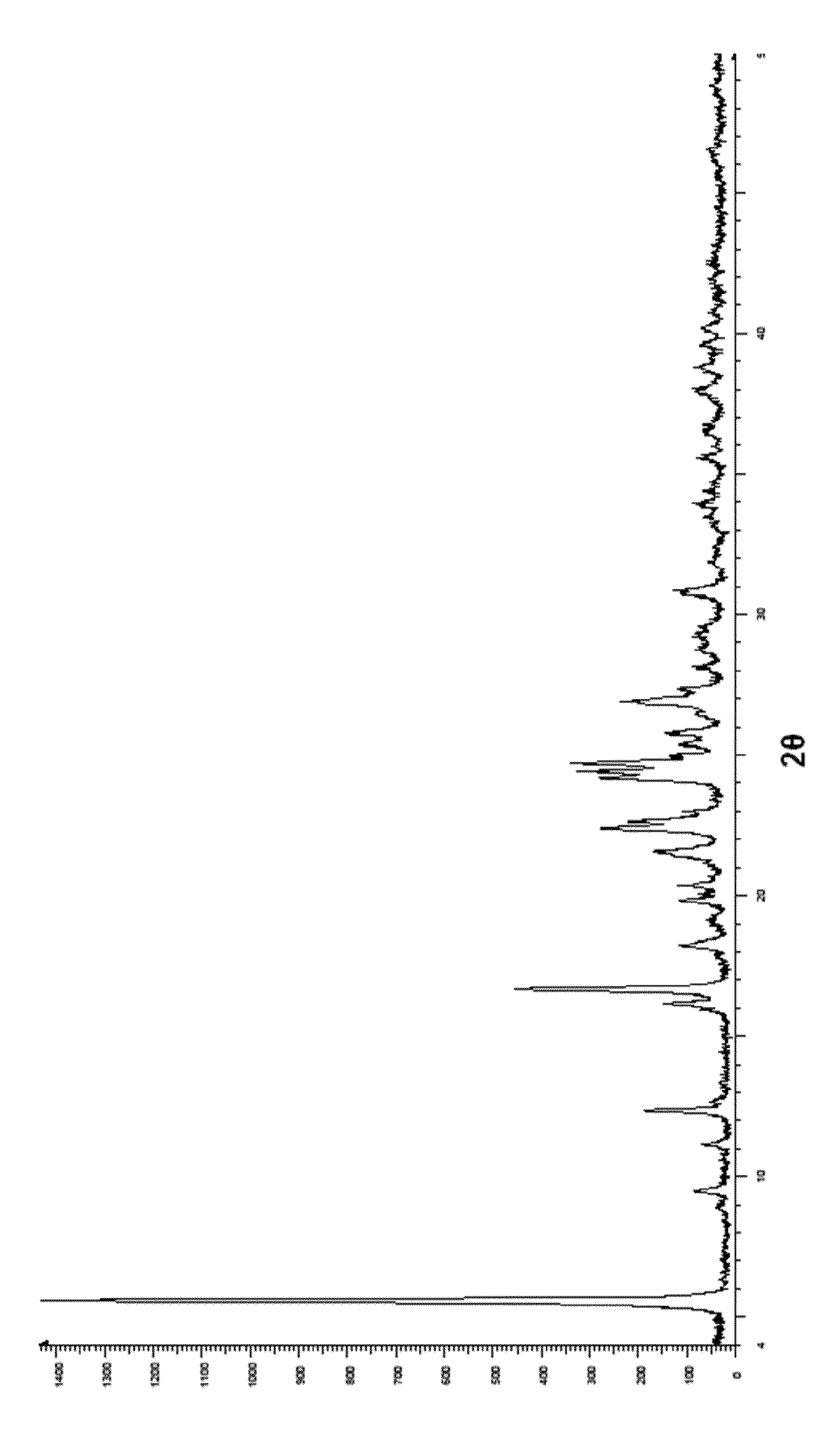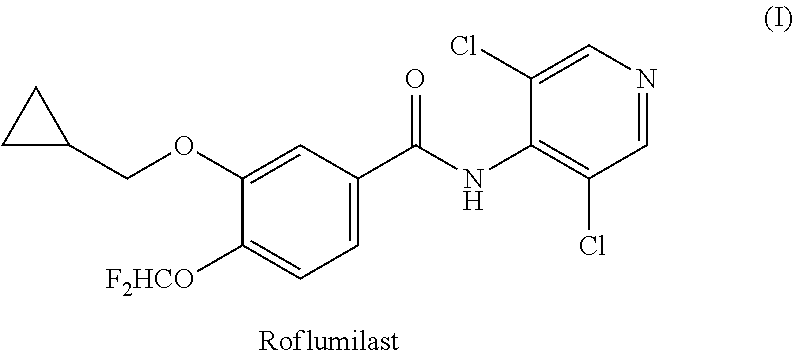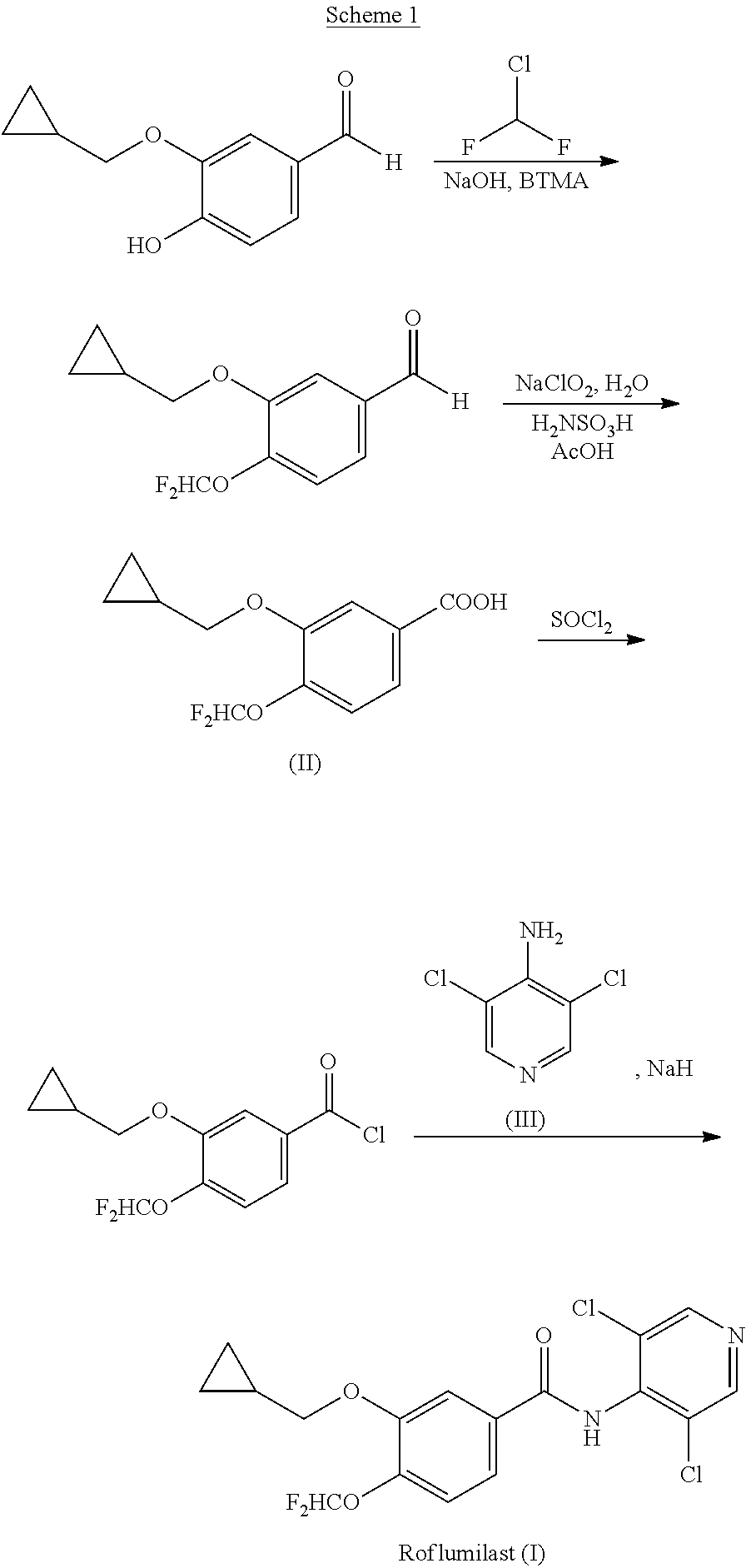Process for preparing roflumilast
a technology of phosphodiesterase and roflumilast, which is applied in the field of phosphodiesterase iv inhibitor compounds, can solve the problems of limiting the contents of thionyl chloride in the final product, the potential risk of genotoxicity, and the toxic reagent thionyl chlorid
- Summary
- Abstract
- Description
- Claims
- Application Information
AI Technical Summary
Benefits of technology
Problems solved by technology
Method used
Image
Examples
example 1
Preparation of 3-(cyclopropylmethoxy)-4-(difluoromethoxy)-benzaldehyde
[0084]55 g of 4-(difluoromethoxy)-3-hydroxybenzaldehyde, 42.42 g of K2CO3 (1.05 eq), 4.86 g of KI (0.1 eq) and 220 mL of dimethylsulphoxide (DMSO) were loaded in a reactor. The mixture was heated at 70° C. and kept for 1 h. A mixture previously prepared of 42.65 g of bromomethyl cyclopropane (1.08 eq) and 110 mL of DMSO was added for 1 hour. The reaction was kept for 3 h at 70° C., and then cooled at room temperature. Once the temperature was reached, 375 mL of toluene was added. The suspension was filtered to remove the remaining K2CO3, and then it was cooled at 0-5° C., and 375 mL of deionised water were loaded. The phases were separated and the organic phase was washed twice with 55 mL of deionised water. The solvent was removed at reduced pressure, obtaining 70 g (yield 99%) of 3-(cyclopropylmethoxy)-4-(difluoromethoxy)-benzaldehyde as a viscous yellowish fluid.
example 2
Preparation of 3-(cyclopropylmethoxy)-4-(difluoromethoxy)-benzoic acid (II)
[0085]40 g of 3-(cyclopropylmethoxy)-4-(difluoromethoxy)-benzaldehyde 160 mL of glacial acetic acid and 32.0 g of sulphamic acid (2.0 eq) were loaded in a reactor. The mixture was cooled at 5-10° C. and the temperature was not allowed to exceed 20° C., adding slowly a previously prepared solution of 44.77 g of sodium chloride and 61 mL of deionised water. After the addition, the reaction was kept for 1 hour at 15-20° C. 450 mL of deionised water was loaded and then it was cooled at 0-5° C. and kept for 1 h at this temperature. The solid was filtered and washed four times with 200 mL of deionised water. The product was dried for 15 h at 40° C., obtaining 36 g (yield 85%) of 3-(cyclopropylmethoxy)-4-(difluoromethoxy)-benzoic acid (II) as solid.
example 3
Preparation of Roflumilast (I)
Preparation of (3-(cyclopropylmethoxy)-4-(difluoromethoxy)-phenyl)(1H-imidazol-1-yl)-methanone (IVa)
[0086]50 mL of tetrahydrofuran (THF) were added to 5.0 g of 3-(cyclopropylmethoxy)-4-(difluoromethoxy)-benzoic acid (II) and 3.46 g of CDI (1.1 eq). The mixture was stirred for 2 h at room temperature. Then, the THF was removed by distillation, obtaining (3-(cyclopropylmethoxy)-4-(difluoromethoxy)-phenyl)(1H-imidazol-1-yl)-methanone (IVa) as viscous oil.
[0087]1H-RMN (DMSO-D6): 8.07 (s, 1H), 7.86 (s, 1H), 7.64-7.57 (m, 2H), 7.27-7.12 (m, 2H), 7.12 (s, 1H), 3.95-3.92 (d, 2H, J=12 Hz), 1.30-1.19, (m, 1H), 0.60-0.34 (dm, 4H).
[0088]13C-RMN (DMSO-D6): 167.44 (C), 149.53 (C), 143.12 (C), 135.27 (CH), 130.59 (C), 122.38 (CH), 121.57 (CH), 120.31 (CH), 116.68 (CH), 114.99 (CH), 112.58 (CH), 73.28 (CH2), 10.11 (CH2), 3.18 (CH).
Formation of Roflumilast
[0089]60 mL of DMSO were added to 3.79 g of 3,5-dichloropyridin-4-amine (III) (1.2 eq) and 0.891 g of NaOH (1.15 eq)...
PUM
| Property | Measurement | Unit |
|---|---|---|
| angle | aaaaa | aaaaa |
| temperature | aaaaa | aaaaa |
| temperature | aaaaa | aaaaa |
Abstract
Description
Claims
Application Information
 Login to View More
Login to View More - R&D
- Intellectual Property
- Life Sciences
- Materials
- Tech Scout
- Unparalleled Data Quality
- Higher Quality Content
- 60% Fewer Hallucinations
Browse by: Latest US Patents, China's latest patents, Technical Efficacy Thesaurus, Application Domain, Technology Topic, Popular Technical Reports.
© 2025 PatSnap. All rights reserved.Legal|Privacy policy|Modern Slavery Act Transparency Statement|Sitemap|About US| Contact US: help@patsnap.com



